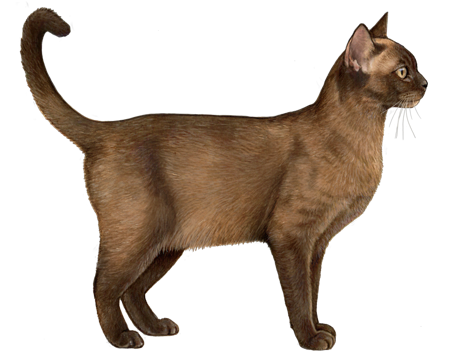
Ocicat
Ocicats may resemble small wildcats. But they're friendly, family-oriented cats at heart. These adorably spotted kitties are also impressive athletes, social butterflies, and devoted pets.
Interested in discovering if your cat is an Ocicat?
Check out Wisdom Panel's DNA test.
Ocicat Traits
General Appearance
Ocicats are medium-sized cats with an athletic, muscular build. They have a wild but graceful appearance and spotted coat that comes in various colors.
Coat and Coloring
The Ocicat's short, sleek coat has a satiny texture. The breed may be 12 different colors: tawny (brown spotted), chocolate, cinnamon, blue, lavender (lilac), fawn, ebony silver, chocolate silver, cinnamon silver, blue silver, lavender silver, and fawn silver. All Ocicats have darker spots that contrast with their lighter primary color.
Except for on the tip of the tail, every hair on an Ocicat has several bands of color. The way these bands combine is what creates the thumbprint-shaped spots on their coats.
Distinctive Physical Traits
Ocicats have wedge-shaped heads, broad muzzles, large, almond-shaped eyes, and alert, moderately large ears. Their legs are medium-length and strong, and their tails are relatively long—with a slight taper and dark tip.
Ocicat Temperament
Confident and people-oriented, Ocicats make devoted family pets. They're smart and can adapt to different environments, as well as learn to follow commands. But because of their social nature and love of attention, they don't like to be left alone. If your schedule requires you to be gone for long hours, consider getting other "sibling" pets to keep them company.
This athletic, active breed has a lot of energy. Ocicats love to play, chase, pounce, and show off their high-jumping abilities. Just be mindful when it comes to games of tug-of-war that some Ocicats can get possessive of their toys.
Many Ocicats have a dog-like disposition and, with training, can learn to fetch or do tricks. But when it's time to settle down, they're more than happy to curl up in the lap of their favorite person.
Ocicat History
The Ocicat owes it beginning to a happy accident. In 1964, Breeder Virginia Daly began crossing Abyssinians with Siamese, hoping to create a Siamese with Aby color points. She didn't expect that the second litter would also include an ivory kitten with golden spots.
Daly's daughter thought this kitten, named Tonga, resembled an ocelot and suggested he be called an Ocicat. Though Tonga was beautiful, Daly's intent was not to breed spotted cats. So, she sold Tonga as a pet under the pretext that the new owner would have the cat neutered.
Shortly after, Daly connected with geneticist Dr. Clyde Keeler. He wanted to develop a breed similar to the extinct Egyptian Spotted Fishing Cat and thought Daly's spotted cat would be an excellent start. Daly repeated her previous steps and produced another spotted male. She then introduced the American Shorthair into the mix for body substance and to bring in the silver color.
Other breeders soon grew interested in Ocicats. But efforts to develop the breed slowed substantially when Daly had to step away from her work to care for a sick relative. After more than a decade, the program started back up. And in 1986, the Ocicat received its first championship status.
Ocicat Care
Nutrition
Ocicats don't have any particular dietary concerns, but they do require high-quality dry or wet food. Because nutritional needs vary for kittens, adults, and senior cats, opt for a formula that's age-appropriate for your pet. And remember to leave fresh, clean water out for your cat at all times.
Grooming
The Ocicat's coat is very low maintenance and doesn't require regular brushing. Their nails, however, should be trimmed monthly. Nails that grow too long can injure your cat's paw pads—leading to pain, infection, or difficulty walking or using the litter box.
Dental care is also core to any grooming routine. Beginning in kittenhood, accustom your Ocicat to regular at-home teeth brushing, as well as periodic exams and professional cleanings.
Health
Roughly one out of every three cats in the United States is overweight or obese. And those extra pounds can contribute to other health risks—such as arthritis, diabetes, and heart problems. Your veterinarian is the best resource for tips on managing your cat's weight.
Ocicat Genetic Health Conditions
-
Mucopolysaccharidosis Type VI
Mucopolysaccharidosis Type VI is a rare disorder causing dwarfism, degenerative joint disease, and clouding of the eyes.
-
Progressive Retinal Atrophy (Discovered in the Abyssinian)
Progressive Retinal Atrophy (Discovered in the Abyssinian) is a disorder that causes degeneration of the light sensing retina at the back of the eye, resulting in vision loss.
With more than 45 health tests, Wisdom Panel™ Complete for Cats screens for these and other important genetic conditions—allowing you to better plan for your cat's lifelong care.
Breed Group
Asian
The Asian Group is comprised mainly of genetically similar breeds which vary widely in traits and personalities. These breeds are distinct from those of the Siamese and Oriental Group.













